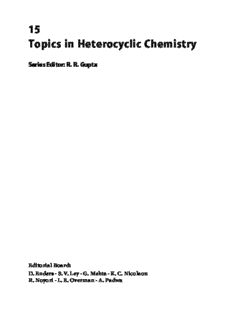
Topics in Heterocyclic Chemistry, v.15. Bioactive Heterocycles VI. Flavonoids and Anthocyanins in Plants, and Latest Bioactive Heterocycles I, 2008, p.290 PDF
Preview Topics in Heterocyclic Chemistry, v.15. Bioactive Heterocycles VI. Flavonoids and Anthocyanins in Plants, and Latest Bioactive Heterocycles I, 2008, p.290
15 Topics in Heterocyclic Chemistry SeriesEditor:R.R.Gupta EditorialBoard: D.Enders·S.V.Ley·G.Mehta·K.C.Nicolaou R.Noyori·L.E.Overman·A.Padwa TopicsinHeterocyclicChemistry SeriesEditor:R.R.Gupta RecentlyPublishedandForthcoming Volumes BioactiveHeterocyclesVI BioactiveHeterocyclesII FlavonoidsandAnthocyaninsinPlants, VolumeEditor:S.Eguchi andLatestBioactiveHeterocyclesI Volume8,2007 VolumeEditor:N.Motohashi Volume15,2008 HeterocyclesfromCarbohydratePrecursors VolumeEditor:E.S.H.ElAshry HeterocyclicPolymethineDyes Volume7,2007 Synthesis,PropertiesandApplications VolumeEditor:L.Strekowski BioactiveHeterocyclesI Volume14,2008 VolumeEditor:S.Eguchi Volume6,2006 SynthesisofHeterocyclesviaCycloadditionsII VolumeEditor:A.Hassner MarineNaturalProducts Volume13,2008 VolumeEditor:H.Kiyota Volume5,2006 SynthesisofHeterocyclesviaCycloadditionsI VolumeEditor:A.Hassner QSARandMolecularModelingStudies Volume12,2008 inHeterocyclicDrugsII VolumeEditor:S.P.Gupta BioactiveHeterocyclesV Volume4,2006 VolumeEditor:M.T.H.Khan Volume11,2007 QSARandMolecularModelingStudies inHeterocyclicDrugsI BioactiveHeterocyclesIV VolumeEditor:S.P.Gupta VolumeEditor:M.T.H.Khan Volume3,2006 Volume10,2007 HeterocyclicAntitumorAntibiotics BioactiveHeterocyclesIII VolumeEditor:M.Lee VolumeEditor:M.T.H.Khan Volume2,2006 Volume9,2007 Microwave-AssistedSynthesisofHeterocycles VolumeEditors:E.VanderEycken,C.O.Kappe Volume1,2006 Bioactive Heterocycles VI FlavonoidsandAnthocyaninsinPlants, andLatestBioactiveHeterocyclesI Volume Editor: NoboruMotohashi Withcontributionsby J.Bariwal·A.Dasgupta·S.G.Dastidar·J.Deli·R.Didiziapetris H.Engi·M.P.Gangeenahalli·N.Gyémánt·J.Hohmann·M.Inabe M.Ishihara·S.Jaldappagari·M.Kawase·H.Kikuchi·M.Kobayashi L.Krenn·T.Kurihara·J.Molnár·N.Motohashi·J.H.Naismith Y.Nakamura·I.Ocsovski·H.Sakagami·Z.Schelz·A.Shah K.Shinohara·Y.Shirataki·G.Spengler·M.Szabo·M.Szücs L.Tanács·H.Wakabayashi 123 TheseriesTopicsinHeterocyclicChemistrypresentscriticalreviewson“HeterocyclicCompounds” withintopic-relatedvolumesdealingwithallaspectssuchassynthesis,reactionmechanisms,structure complexity,properties,reactivity,stability,fundamentalandtheoreticalstudies,biology,biomedical studies,pharmacologicalaspects,applicationsinmaterialsciences,etc.Metabolismwillbealsoin- cludedwhichwillprovideinformationusefulindesigningpharmacologicallyactiveagents.Pathways involving destruction of heterocyclic rings will also be dealt with so that synthesis of specifically functionalizednon-heterocyclicmoleculescanbedesigned. Theoverallscopeistocovertopicsdealingwithmostoftheareasofcurrenttrendsinheterocyclic chemistrywhichwillsuittoalargerheterocycliccommunity. Asarulecontributionsarespeciallycommissioned.Theeditorsandpublisherswill,however,always bepleasedtoreceivesuggestionsandsupplementaryinformation.PapersareacceptedforTopicsin HeterocyclicChemistryinEnglish. In references Topics in HeterocyclicChemistry is abbreviated Top HeterocyclChemandis cited as ajournal. SpringerWWWhomepage:springer.com VisittheTHCcontentatspringerlink.com ISBN978-3-540-79217-8 e-ISBN978-3-540-79218-5 DOI10.1007/978-3-540-79218-5 TopicsinHeterocyclicChemistryISSN1861-9282 LibraryofCongressControlNumber:2008924618 (cid:1)c 2008Springer-VerlagBerlinHeidelberg Thisworkissubjecttocopyright.Allrightsarereserved,whetherthewholeorpartofthematerial isconcerned,specificallytherightsoftranslation,reprinting,reuseofillustrations,recitation,broad- casting,reproductiononmicrofilmorinanyotherway,andstorageindatabanks.Duplicationof thispublicationorpartsthereofispermittedonlyundertheprovisionsoftheGermanCopyrightLaw ofSeptember9,1965,initscurrentversion,andpermissionforusemustalwaysbeobtainedfrom Springer.ViolationsareliabletoprosecutionundertheGermanCopyrightLaw. Theuseofgeneraldescriptivenames,registerednames,trademarks,etc.inthispublicationdoesnot imply, even in the absence of a specific statement, thatsuchnamesareexempt fromthe relevant protectivelawsandregulationsandthereforefreeforgeneraluse. Coverdesign:WMXDesignGmbH,Heidelberg TypesettingandProduction:le-texpublishingservicesoHG,Leipzig Printedonacid-freepaper 9876543210 springer.com SeriesEditor Prof.R.R.Gupta† 10A,VasundharaColony LaneNo.1,TonkRoad Jaipur-302018,India [email protected] VolumeEditor DirectorandFormerProf.NoboruMotohashi MeijiPharmaceuticalUniversity 4-31-23Shimosyakujii Nerima-ku,Tokyo 177-0042Japan [email protected] EditorialBoard Prof.D.Enders Prof.K.C.Nicolaou RWTHAachen Chairman InstitutfürOrganischeChemie DepartmentofChemistry D-52074,Aachen,Germany TheScrippsResearchInstitute [email protected] 10550N.TorreyPinesRd. LaJolla,California92037,USA Prof.StevenV.LeyFRS [email protected] and BP1702Professor ProfessorofChemistry andHeadofOrganicChemistry DepartmentofChemistryandBiochemistry UniversityofCambridge UniversityofCalifornia DepartmentofChemistry SanDiego,9500GilmanDrive LensfieldRoad LaJolla,California92093,USA Cambridge,CB21EW,UK [email protected] Prof.G.MehtaFRS Director DepartmentofOrganicChemistry IndianInstituteofScience Bangalore-560012,India [email protected] VI EditorialBoard Prof.RyojiNoyoriNL Prof.LarryE.Overman President DistinguishedProfessor RIKEN(TheInstituteofPhysicalandChem- DepartmentofChemistry icalResearch) 516RowlandHall 2-1Hirosawa,Wako UniversityofCalifornia,Irvine Saitama351-0198,Japan Irvine,CA92697-2025 and [email protected] UniversityProfessor DepartmentofChemistry Prof.AlbertPadwa NagoyaUniversity WilliamP.TimmieProfessorofChemistry Chikusa,Nagoya464-8602,Japan DepartmentofChemistry [email protected] EmoryUniversity Atlanta,GA30322,USA [email protected] TopicsinHeterocyclicChemistry AlsoAvailableElectronically ForallcustomerswhohaveastandingordertoTopicsinHeterocyclicChem- istry, we offer the electronic version via SpringerLink free of charge. Please contact your librarian who can receive a password or free access to the full articlesbyregisteringat: springerlink.com Ifyoudonothaveasubscription,youcanstillviewthetablesofcontentsofthe volumesandtheabstractofeacharticlebygoingtotheSpringerLinkHome- page,clickingon“BrowsebyOnlineLibraries”,then“ChemicalSciences”,and finallychooseTopicsinHeterocyclicChemistry. Youwillfindinformationaboutthe – EditorialBoard – AimsandScope – InstructionsforAuthors – SampleContribution atspringer.comusingthesearchfunction. Color figures are published in full color within the electronic version on SpringerLink. Preface AspartoftheseriesTopicsinHeterocyclicChemistry,thisvolumetitledBioac- tiveHeterocyclesIIpresentscomprehensiveandup-to-datereviewsonselected topicsconcerningflavonoidsandanthocyaninsinplants,andheterocyclessuch asbioactivephenothiazines, phenoxazines, andrelatedcompounds.Thevol- umeisseparatedintotwosectionsmainlyconcentratingonthesetwotopics. There areabundant anddiverse flavonoidswithcarbohydratesandlipids, alkaloids (betalain alkaloids and other alkaloids), phenols (chromones,cou- marins,lignans,quinines,andotherphenolics),terpenoids(monoterpenoids, sesquiterpene lactones, triperpenoid saponins, carotenoids, and other ter- penoids),andmineralsasmicronutritionalphytochemicalsinfruitsandveg- etables of our daily diets. Among these phytochemicals, the flavonoids have specificfunctionalityinrelationtoage-relateddiseasessuchashypertension, diabetes,cardiacinfarction,cataracts,andcancer.Theauthorsofeachchapter inthefirstsectionhavepresentedtheirevidenceinrelationtothemechanism ofthepreventativeandtherapeuticabilityofthecompounds. Thefirstchapter,“FunctionalityofAnthocyaninsasAlternativeMedicine” byNoboruMotohashiandHiroshiSakagami,presentstheirantioxidantmech- anismforanthocyanidins, whicharepresentincommonfoods.Itispossible that anthocyanins may have been used both preventatively and clinically as partofmany“folkloremedicines”worldwideandmayhaveprovidedhealth- carebenefitssincetheappearanceofmankindsome7.5millionyearsago.The reviewwillinformthereaderastotheirfunctionalityandmechanism. Thesecondchapter,“BioactiveMechanismofInteractionbetweenAntho- cyaninsandMacromoleculesLikeDNAandProteins”bySeetharamappaJal- dappagari,NoboruMotohashi,MamathaP.Gangeenahalli,andJamesH.Nai- smith,presentsthebiologicalactivitiesofanthocyanins,andtheinteractions ofanthocyanins withDNA and protein. Anthocyanins might protectagainst damagetohealthbysometypesofharmfuloxidantsthroughvariousmech- anisms such as their antioxidative activity, protein active site binding, and chelating complexformation. The review presents theinteresting interactive mechanismofanthocyanin–DNAcomplexformation. The thirdchapter,“Antibacterial ActivityofArtificial Phenothiazines and IsoflavonesfromPlants”byAsishDasgupta,SujataGhoshDastidar,Yoshiaki Shirataki,andNoboruMotohashi,presentsthatsyntheticphenothiazinesand X Preface isoflavononesare not only powerful antibacterial agents as revealed by their activityintestswithhundreds ofbacteria, butoftenalsoactasantiviraland anticancer agents. Many such compounds can eliminate drug-resistant plas- midsandactivelyparticipateininhibitionofeffluxpumpsinpathogens.This studyhasopenedupanewdomaininthefieldofantimicrobialchemotherapy sincethesecompoundscanbeadministeredinhumansstraightawayormay befurtherimprovedbystructuralmodifications. Thefourthchapter,“InhibitionofMultidrugResistanceofCancerCellsby SelectedCarotenoids,FlavonoidsandAnthocyanins”byJosephMolnár,Helga Engi, Nóra Gyémánt, Zsuzsanna Schelz, Gabriella Spengler, Imre Ocsovszki, Miklós Szücs, Judith Hohmann, Margaret Szabó, Lajos Tanács, Péter Mol- nár, Joseph Deli, Liselotte Krenn, Masami Kawase, Hidetsugu Wakabayashi, Teruo Kurihara, Yoshiaki Shirataki, Hiroshi Sakagami, Noboru Motohashi, and Remigijus Didiziapetris, tried to indirectly define receptor-structure in the presence of the diverse structurally unrelated carotenoids, flavonoids, isoflavonoids,andterpenoids.Thisreviewmaycontributetostudiesofmulti- drug-resistant(MDR)proteinsthatbelongtotheATP-bindingcassettesuper- familywhicharepresentinamajorityofhumantumorsandareanimportant finalcauseoftherapeuticfailure. Thefifthchapter,“ChangesinPolyamineLevelsduringCellDeathInduced byHeterocycles”byMasakiKobayashi,HiroshiSakagami,MasamiKawase,and NoboruMotohashi,presentschangesinpolyaminelevelsduringcelldeathin- duced by selective properties of diverse heterocycles such as phenoxazines, flavonoids, and other heterocycles. Natural polyamines (putrescine, spermi- dine, spermine) are aliphatic amines containing two or more amino groups, whichplayimportantrolesinregulating cellgrowthanddifferentiation. De- pletion of polyamine in cells has been known to inhibit cell proliferation or induce celldeath. This review might helpthe studyofchangesin polyamine levelsoncelldeathwheninducedbyheterocycles. Inthesecondsectionofthevolume,N-heterocyclessuchasphenothiazines, phenoxazines, dihydropyridines, and related compounds are shown also to have interesting biological activity including antitumor activity, vermicide, antibacterial activity, and antischizophrenic activity (i.e. chlorpromazine of thephenothiazinefamilyanditsanalogs).Theactivityofphenothiazineand compounds such as phenoxazines and related heterocycles, and also recent bioactivemesoionicheterocycleswillbediscussed. The sixth chapter, “Tumor-Specificity and Type of Cell Death Induced by Heterocycles”by HiroshiSakagami, Masaki Kobayashi, Mariko Ishihara, Hi- rotaka Kikuchi, Yukio Nakamura, Masami Kawase, and Noboru Motohashi, presents the tumor specificities of trifluoromethylimidazoles, phenoxazines, 3-formylchromonederivatives, coumarinanditsderivatives, andvitaminK 2 derivatives andthetypeofcelldeathinduced bythese heterocycles. Thisre- view might beneficially establish a definitive strategy for the exploration of newhighlytumor-selectivecompounds.Also,thescreeningprocessofhighly Preface XI tumor-specific compounds should be introduced before the identification of thetypeofcelldeath(either apoptosis, autophagy, ornecrosis)and thecell- deathinductionmechanism. Theseventhchapter,“AdvancedDihydropyridinesasNovelMultidrugRe- sistanceModifiersandReversing Agents”byAnamikShah,Jitender Bariwal, Joseph Molnár, Masami Kawase, and Noboru Motohashi, presents a com- prehensive review of their synthetic methodologyfor the preparation of the most-activeP-glycoprotein(Pgp)inhibitordihydropyridine.These“privilege structured” families of compounds are potent inhibitors of P-glycoprotein, whicharethemaincauseofeffluxoftoxinsfromthecells.Thisreviewmight beusefulforexploratoryfuturedrug development duetothePgpinhibitory propertyofthedihydropyridines. Thelastchapter,“TheoreticalStudiesonPhenothiazines,Benzo[a]pheno- thiazinesandBenz[c]acridines”byTeruoKurihara,KazumiShinohara,Hidet- sugu Wakabayashi, Noboru Motohashi, Hiroshi Sakagami, and Joseph Mol- nár, presents their quantitative structure–activity relationship (QSAR) anal- ysis for minimum inhibitory concentration (MIC) of phenothiazines and benzo[a]phenothiazines. The MIC values of phenothiazines were well cor- relatedto∆∆Hf,HOMOenergy,andµG.QSARmaybeapplicabletopredict theMICofphenothiazines. Thisreviewcouldcontributetopredictionofthe relationshipofstructuretobiologicalactivity. Itishopedthatthisvolumewillserveasastimulusforresearcherswithan interest in the field of biologicalactivity of flavonoids and heterocycles, and alsostimulatefurtherdevelopmentfornoveltherapeutics. Tokyo,March2008 NoboruMotohashi
Description: